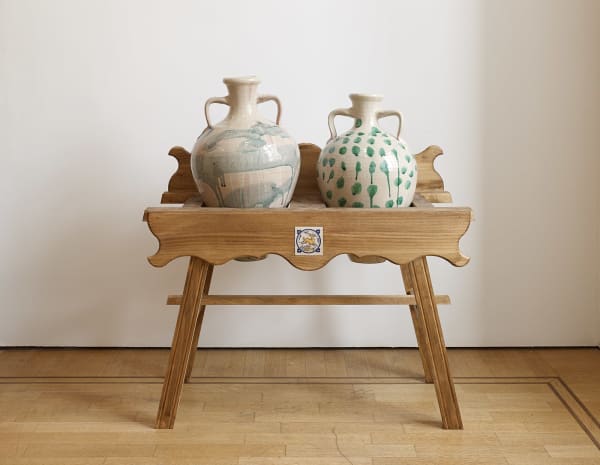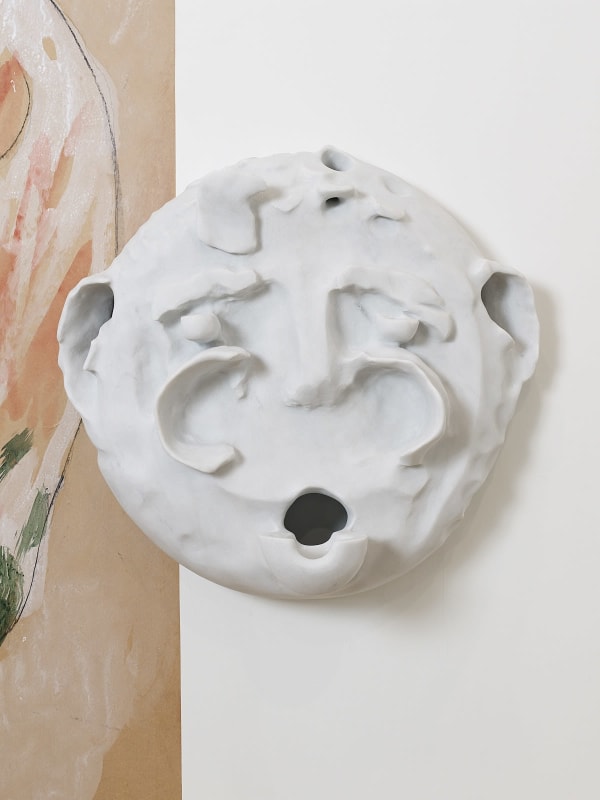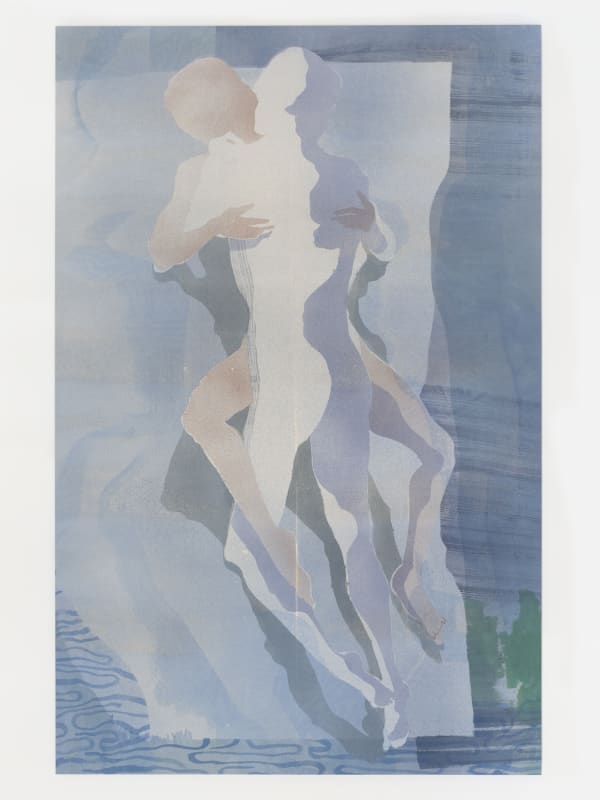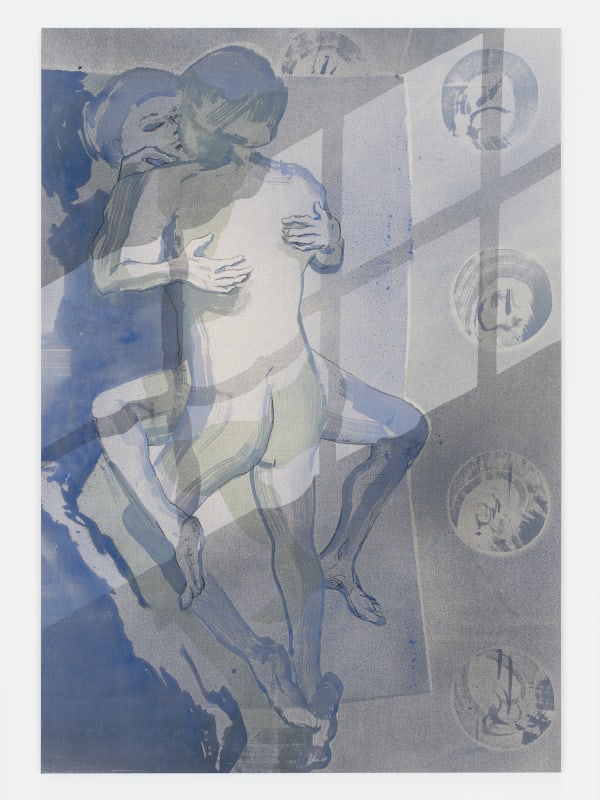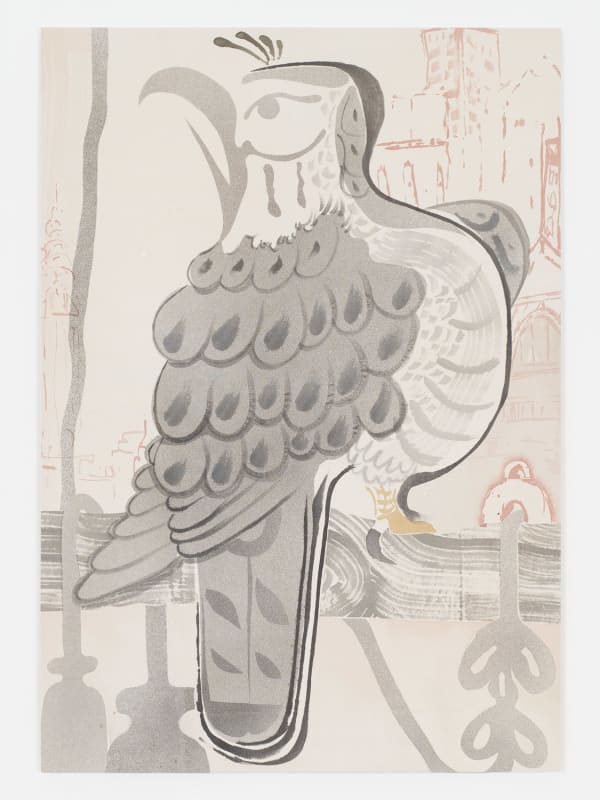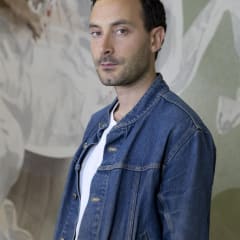Two Hands on Earth Matthew Lutz-Kinoy
Mendes Wood DM presents Two Hands on Earth, an exhibition of new works by Matthew Lutz-Kinoy. Utilizing the gallery’s interior and period features, the show proposes a stage where the interconnectedness of the works and the gallery come into focus. Within this mise-en-scène, Lutz-Kinoy elaborates on his investigation into the tangible conditions to stage utopia and depictions of heaven on earth.
Art historian T.J. Clark recognizes the potential paintings have to create such conditions, since this lies in their advantage to both tell a story without putting anything into words, and to un-tell a story without adhering to the limits of orality. The ability painting has, perhaps more than any other means of representation, is to convey images of a world transfigured – be these entirely familiar or concrete, calling out our established responses, with everything in it larger or lighter than life.
In the entrance of the exhibition, we are faced with a vertical painting placed centrally in the gallery’s staircase. Announcement in The Land of Cockaigne (2019) depicts a color gradient grounded in a forest green that quickly transitions to a vibrant red. A bowed angel’s arm thrusts out from in-between a pair of wings pointing downwards towards two cuddling pigs in a cozy embrace. The reaching arm signals the sacrificial status of the pigs as a signifier of immaculate conception – an announcement from above.
Bruegel’s painting The Land of Cockaigne depicts a dreamlike Garden of Eden – a mythical land of plenty, where the poor are rich and where food and sex are freely available. This Bruegelian peasant fantasy is particularly felt in the exhibition’s ground floor room, where the works respond to this intensified imagery. In this room Lutz-Kinoy interprets this intensity through scale, where the motif of coupling pigs multiplies as hand-drawn posters, and large marble masks hang on the walls, creating a temple-like architecture. The marble sculptures announce a development from his previous masks tied closely to the ceramic act of compiling elements thrown on the wheel. These marble works use an original mask as a maquette but are carved out of one continues stone. The process of marble carving distances the artist’s hand while at the same time deepens an engagement with earth bound materials.
This scaling up continues on the first floor with depictions of lovers. In Blue After Balthrop (2019) two massive figures in a love-making embrace are seen from above. The scene is lifted from Alvin Baltrop’s photographs of men cruising the dilapidated Hudson River piers. Its monochrome pallet places a blue filter over the black and white of Baltrop’s pictures. There is a crisp shadow that traces the curves of their bodies while a decorative motif of water curves at the bottom of the painting.
Queer academician José Esteban Muñoz argues that queer culture does not depend on the notion of futurity, since futurity is a fantasy of heterosexual reproduction. If utopias are only to be conceived biologically, we can imagine how this can be problematic for a non-reproductive body. Creating these figures through a stenciling technique, they exist not through their features but through their shape and gesture. In his paintings of lovers, the bird’s-eye perspective creates a topology – the graphic body is read as a map. The negative/positive of the stencil technique mirrors the photographic process, emphasizing a dependence on light.
This relationship to light brings us back to Lutz-Kinoy’s response to the exhibition space itself. The large-format paintings are created in response to the brilliant windows that bookend the gallery. These works expose the tension between the fantastic and lived experience, emphasizing the light in which we view painting and the light that brings us out of darkness.
The sculptures in the exhibition are made possible by the artisans of the DalleNogare Graniti & Marmi, Bolzano IT, Cerámica Los Arraynes, Granada SP and the ongoing collaborations in ceramic with the artist Natsuko Uchino.
– Thomas Rackowe Cork
-
 Matthew Lutz-Kinoy, "I am writing and it is about you...", 2019
Matthew Lutz-Kinoy, "I am writing and it is about you...", 2019 -
 Matthew Lutz-Kinoy, "I am writing and it is about you...", 2019
Matthew Lutz-Kinoy, "I am writing and it is about you...", 2019 -
 Matthew Lutz-Kinoy, "I am writing and it is about you...", 2019
Matthew Lutz-Kinoy, "I am writing and it is about you...", 2019 -
 Matthew Lutz-Kinoy, "I am writing and it is about you...", 2019
Matthew Lutz-Kinoy, "I am writing and it is about you...", 2019 -
 Matthew Lutz-Kinoy, Two Hands on Earth, 2019
Matthew Lutz-Kinoy, Two Hands on Earth, 2019 -
 Matthew Lutz-Kinoy, Two Hands on Earth, 2019
Matthew Lutz-Kinoy, Two Hands on Earth, 2019 -
 Matthew Lutz-Kinoy, Two Hands on Earth, 2019
Matthew Lutz-Kinoy, Two Hands on Earth, 2019 -
 Matthew Lutz-Kinoy, Stealing What's Real New York, 2019
Matthew Lutz-Kinoy, Stealing What's Real New York, 2019 -
 Matthew Lutz-Kinoy, The Announcement in The Land of Cockaigne, 2019
Matthew Lutz-Kinoy, The Announcement in The Land of Cockaigne, 2019 -
 Matthew Lutz-Kinoy, Every Eden, 2019
Matthew Lutz-Kinoy, Every Eden, 2019 -
 Matthew Lutz-Kinoy, Blue after Baltrop, 2019
Matthew Lutz-Kinoy, Blue after Baltrop, 2019 -
 Matthew Lutz-Kinoy, The Lion Hunt, 2019
Matthew Lutz-Kinoy, The Lion Hunt, 2019 -
 Matthew Lutz-Kinoy, The Subbasement of craft, after Atarfe, 2019
Matthew Lutz-Kinoy, The Subbasement of craft, after Atarfe, 2019 -
 Matthew Lutz-Kinoy, The Subbasement of craft, after Oyamazaki, 2019
Matthew Lutz-Kinoy, The Subbasement of craft, after Oyamazaki, 2019 -
 Matthew Lutz-Kinoy & Natsuko Uchino, Keramikos 3, 2019
Matthew Lutz-Kinoy & Natsuko Uchino, Keramikos 3, 2019 -
 Matthew Lutz-Kinoy, Cleanse, 2019
Matthew Lutz-Kinoy, Cleanse, 2019 -
 Matthew Lutz-Kinoy & Natsuko Uchino, Keramikos 3, 2019
Matthew Lutz-Kinoy & Natsuko Uchino, Keramikos 3, 2019 -
 Matthew Lutz-Kinoy, Freaks Need Homes, 2019
Matthew Lutz-Kinoy, Freaks Need Homes, 2019 -
 Matthew Lutz-Kinoy, Country Falcon, 2019
Matthew Lutz-Kinoy, Country Falcon, 2019 -
 Matthew Lutz-Kinoy, City Falcon, 2019
Matthew Lutz-Kinoy, City Falcon, 2019 -
 Matthew Lutz-Kinoy, Scrolls in the Wind A collection of scripts and poems by Harry Burke, Cyrus Grace Dunham, Sharon Hayes, James English Leary, Sophy Naess, Amy Sillman and Emily Sundblad. Edited by Matthew Lutz-Kinoy, 2018
Matthew Lutz-Kinoy, Scrolls in the Wind A collection of scripts and poems by Harry Burke, Cyrus Grace Dunham, Sharon Hayes, James English Leary, Sophy Naess, Amy Sillman and Emily Sundblad. Edited by Matthew Lutz-Kinoy, 2018


